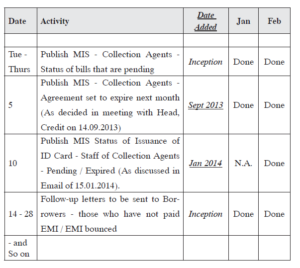
As I went up the ranks – Team Member…Team Leader…Asst. Manager…Manager…Asst. Vice President… – I knew I was capturing a wealth of knowledge and experience in my checklists. It had helped me to do the job better and was going to help those who came after me.
But then what you have a firm faith on is not something that others will equally share. That is the situation I faced when I had a 5-manager, 50-member team reporting to me.
How do I get my team down the ranks to take their checklists – the most boring thing ever – seriously?
How do I get them to diligently update their checklists with new learning – Error, Audit Observation, Regulatory Directive, new Process Note, etc. – as it happened, every day, week, and month?
Not willing to take chances – and under the belief it shouldn’t take much time – I tried to do it all by myself.
As the days passed and I observed things, I noted in a draft email ‘Items to be updated in Checklists’. And then every Friday I used to diligently update the relevant checklists in my team.
But soon it got overwhelming for me.
Then I tried another option. I used to sit with a manager once a fortnight to see if the checklists in his team were getting updated with new learning.
But again it would get overwhelming for me.
The volume of new learning that gets generated in a department every week and month is brutal and exhausting.
Finally, I thought of a time-efficient way to drive home the point.
I asked the managers to send me their checklist (Excel) every month by the 7th, on email, confirming the adherence to activities in the previous month.
Importantly, I asked them to include a column – Date Added – to indicate when a specific item (learning) was added in their checklist.
So, a Manager, Credit Operation, would send me an Excel file every month like under:

Now it was good.
This ‘date added’ column gave me a comfort that managers were diligently updating the learning in their checklist. If in a month, I didn’t find five or six items added or updated in a manager’s checklist, I would dig deep and question.
As regards checking for adherence – with everything on email, it took me just 10 minutes to go through one checklist.
5 managers – 60 minutes max to review a month’s activity! It was incredibly time-efficient.
Importantly, the above helped as under:
i. The managers in turn implemented this – Excel confirmation on email – with their team leaders and so on down the ranks.
ii. All the checklists were now above board, clearly visible – and not hidden in some long-lost lan directory. Any time a learning occurred – Error / Audit Observation / New Process / Regulatory Directive – a manager could, in five minutes, check if the relevant checklist had been updated in his team.
As we go up the ranks, a review of checklists remains our best bet – and the most time-efficient one – to ensure and enforce due diligence the way it’s supposed to be.
————-
This article is part of a bigger article – How to reduce errors at Work?